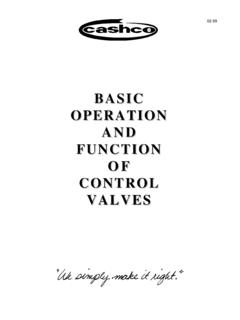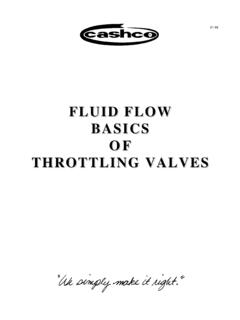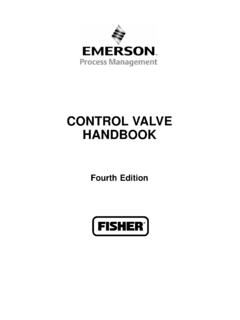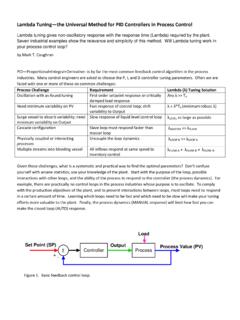Transcription of BASIC OPERATION AND FUNCTION OF CONTROL VALVES
1 BASICBASICOPERATIONOPERATIONANDANDFUNCTI ONFUNCTIONOFOFCONTROLCONTROLVALVESVALVES 02-99- 2 -That valvedrives me crazy!??What ishappening insidethat valve??Gaskets Won't Seal!Unusually HighTrim Maintenance!!Packing Always Leaks!NOISY!!VIBRATING!!Positioner AlwaysNeeds Calibration!Too much seat leakage!LOUSY CONTROL !RATTLING!Table of ContentsTOPIC - SUBJECTSECTIONT erminology------------------------------ -------------------------------- 1 CONTROL Valve BASIC Designs --------------------------------------- 2 Characterization and Trim Design -------------------------------- 3 CONTROL Valve Technical Considerations ----------------------- 4 Force-Balance Principle ---------------------------------------- ----- 5 Actuator BASIC Designs ---------------------------------------- ------ 6 CONTROL Valve Unit Action ---------------------------------------- --- 7 Actuator Benchset Range ---------------------------------------- --- 8 Valve Positioner Basics ---------------------------------------- ------ 9 CONTROL Loop Action ---------------------------------------- ---------- 10 CONTROL Valve Packing Designs ----------------------------------- 11 Seat Leakage
2 ---------------------------------------- -------------------- 12- 3 -SECTION 1 Terminology- 4 - CONTROL VALVE TERMINOLOGY(per ) AND PURPOSETo provide a glossary to define terms commonly used in CONTROL valve DEFINITIONS actuator: An actuator is a pneumatic hydraulic, or electrically powered device which supplies force andmotion to open or close a : A regulator which is used to CONTROL the supply pressure to the valve actuator and its valve: A valve design in which one port is collinear with the valve stem or actuator, and the otherport is at a right angle to the valve trim: See trim, anti-cavitation .anti-noise trim: See trim, anti-noise .bellows stem seal: A thin wall, convoluted, flexible component that makes a seal between the stem andbonnet or body and allows stem motion while maintaining a hermetic : The calibration of the actuator spring range of a CONTROL valve, to account for the in serviceprocess : The main pressure boundary of the valve that also provides the pipe connecting ends, the fluid flowpassageway, and supports the seating surfaces and the valve closure : The portion of the valve that contains the packing box and stem seal and may guide the stem.
3 Itmay also provide the principal opening to the body cavity for assembly of internal parts or be an integralpart of the valve body. It may also provide for the attachment of the actuator to the valve body. Typicalbonnets are bolted, threaded, welded to, pressure-sealed, or integral with the valve: A valve with a circular body and a rotary motion disk closure member, pivotally supportedby its : A part of a valve trim that surrounds the closure member and may provide flow characterization and/or a seating surface. It may also provide stability, guiding, balance, and alignment, and facilitate assemblyof other parts of the valve : The rate of flow through a valve under stated : A two-stage phenomenon of liquid flow. The first stage is the formation of vapor bubbles withinliquid system due to static pressure of fluid at vena contracta falling below the fluid vapor pressure; thesecond stage is the collapse or implosion of these cavities back into an all-liquid state as the fluid deceler-ates and static pressure is , flow: An indefinite term, see characteristic, inherent flow and characteristic, installedflow.
4 - characteristic, equal percentage: An inherent flow characteristic which, for equal increments of ratedtravel, will ideally give equal percentage changes of the existing flow coefficient (Cv).- 5 -- characteristic, inherent: The relationship between the flow coefficient (Cv) and the closure membertravel as it is moved from the closed position to rated travel with constant pressure drop across characteristic, linear: An inherent flow characteristic that can be represented by a straight line on arectangular plot of flow coefficient (Cv) versus rated travel. Therefore, equal increments of travelprovide equal increments of flow coefficient (Cv).- characteristic, quick opening: An inherent flow characteristic in which a maximum flow coefficient isachieved with minimal closure member cam: A component in a valve positioner used to relate the closure member position to thecontrol trim: CONTROL valve trim that provides predefined flow member: The movable part of the valve that is positioned in the flow path to modify the rate offlow through the member configurations (plug):- characterized: Closure member with contoured surface, such as the vee plug, to provide variousflow cylindrical: A cylindrical closure member with a flow passage through it (or a partial cylinder).
5 - eccentric: Closure member face is not concentric with the stem centerline and moves into seat eccentric spherical disk: Disk is spherical segment, not concentric with the disk linear: A closure member that moves in a line perpendicular to the seating rotary: A closure member which is rotated into or away from a seat to modulate , flow: A constant (Cv) related to the geometry of a valve, for a given valve travel, that can beused to predict flow valve: A valve which controls the flow rate or flow direction in a fluid system. The final controlelement, through which a fluid passes, that adjusts the flow passage as directed by a signal from a cont-roller to modify the flow sealing valve: A valve that uses a resilient seating material for the primary seal and a metal-to-metalseat for a secondary connection: The configuration provided to make a joint with the end connections, flanged: Valve body with end connections incorporating flanges that mate with cor-responding flanges on the end connections, split clamp : Valve end connections of various proprietary designs using splitclamps to apply gasket or mating surface end connections, threaded: Valve end connections incorporating threads, either male or end connections, welded: Valve end connections which have been prepared for welding to the linepipe or other fittings.
6 May be butt weld (BW), or socket weld (SW).- 6 -erosion resistant trim: Valve trim, that has been designed with special surface materials or geometry toresist the erosive effects of the controlled fluid bonnet: A bonnet with a packing box that is extended above the bonnet joint of the valve bodyso as to maintain the temperature of the packing above or below the temperature of the process fluid. Thelength of the extension bonnet is dependent upon the difference between the fluid temperature and thepacking design temperature limit as well as upon the valve body to face dimension: The dimension from the face of the inlet opening to the face of the outlet openingof a valve or , flange: The finish on the end connection that mates with gasket mode: The position to which the valve closure member moves when the actuating energy fail-closed: A condition wherein the valve closure member moves to a closed position when the ac-tuating energy source fail-in place: A condition wherein the valve closure member stays in its last position when the actuat-ing energy source fail-open: A condition wherein the valve closure member moves to an open position when the actuat-ing energy source fail-safe.
7 A characteristic of a particular valve and its actuator, which upon loss of actuating energysupply, will cause a valve closure member to fully close, fully open or remain in fixed last position. Fail-safe action may involve the use of auxiliary controls connected to the CONTROL valve: A valve without integral line flanges, which is installed by bolting betweencompanion flanges, with a set of bolts, or studs, generally extending through the companion , closure component: The means by which the closure is aligned with the seat and held stablethroughout its travel. The guide is held rigidly in the body, bonnet, and/or bottom jack: A manual override device, using a lever, to stroke a valve or to limit its : A mechanical manual override device, using a rotary wheel, to stroke a valve or to limit facing: A material applied to valve internals to resist fluid erosion and/or to reduce the chance ofgalling between moving parts, particularly at high plating: A thin metal deposit, sometimes electroplated, used to induce surface hardening.
8 Hardplating is many orders of magnitude thinner than hard : The maximum difference in output value for any single input value during a calibration cycle,excluding errors due to dead seat: A flow CONTROL orifice and seat that is an integral part of the body or VALVES : A valve body cast with a double wall or provided with a double wall by welding materialaround the body so as to form a passage for a heating or cooling medium. Also refers to VALVES which areenclosed in split metal jackets having internal heat passageways or electric heaters. Also referred to as steam jacketed or vacuum jacketed. In a vacuum jacketed valve, a vacuum is created in the spacebetween the body and secondary outer wall to reduce the transfer of heat by convection from the at-mosphere to the internal process fluid, usually 7 -lantern ring: A rigid spacer assembled in the packing box with packing normally above and below it anddesigned to allow lubrication of the packing or access for a leak-off : A process of mating contact surfaces by grinding and/or , class: Classifications established by ANSI to categorize seat leakage tolerances fordifferent sizes of CONTROL valve , seat: The quantity of fluid passing through a valve when the valve is in the fully closed positionwith pressure differential and temperature as gland.
9 A packing box with packing above and below the lantern ring so as to provide a collectionpoint for fluid leaking past the primary seal (lower packing).lined valve body: A valve body in which a coating or liner has been applied to internal surfaces for cor-rosion/erosion protection or for flow shut , slip-in: An annular shaped liner which makes a slight interference fit with the body bore and whichmay be readily forced into position through the body end. May be plain or reinforced. Applies to pressure recovery factor: The ratio (FL) of the valve flow coefficient (Cv) based on the pressuredrop at the vena contracta, to the usual valve flow coefficient (Cv) which is based on the overall pressuredrop across the valve in non-vaporizing liquid service. These coefficients compare with the orifice meteringcoefficients of discharge for vena contracta taps and pipe taps, respectively.
10 See ControlValve Sizing Equations. lubricator isolating valve: A manually operated valve used to isolate the packing lubricator assembly fromthe packing packing box: A packing arrangement consisting of a lantern ring with packing rings above andbelow with provision to lubricate the limit stop: A mechanical device to limit the valve stem position: The location and orientation of an actuator or auxiliary component relative to thecontrol valve. This can apply to the CONTROL valve itself relative to the orifice: A style of valve trim where the flow passes through a multiple of orifices in parallel or size: A numerical designation of size which is common to all components in a piping system otherthan components designated by outside diameters or by thread size. It is a convenient round number forreference purposes and is only loosely related to manufacturing dimensions.






